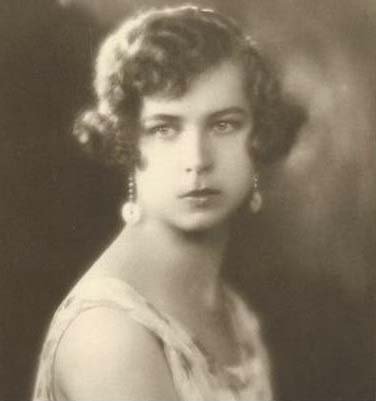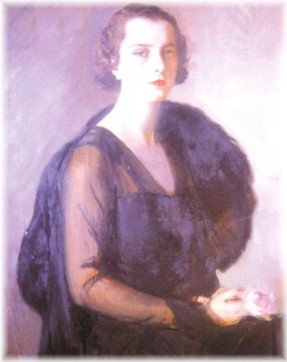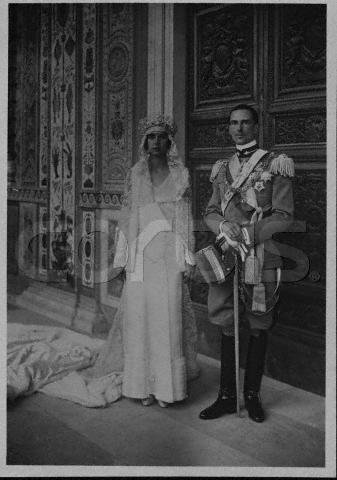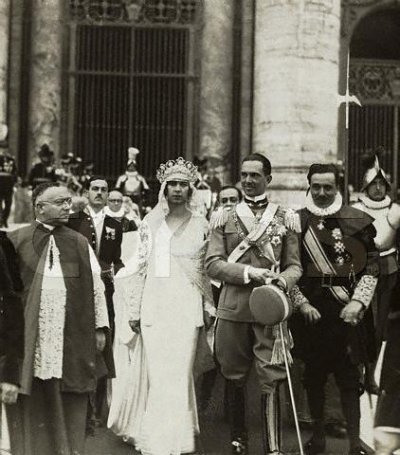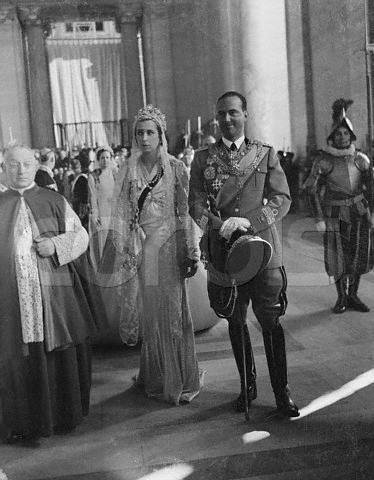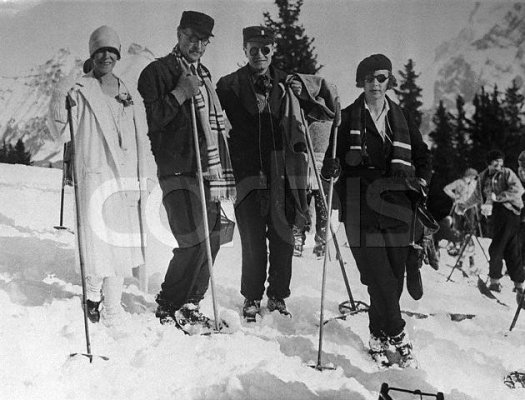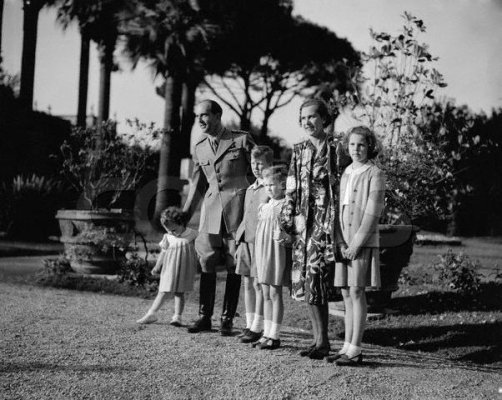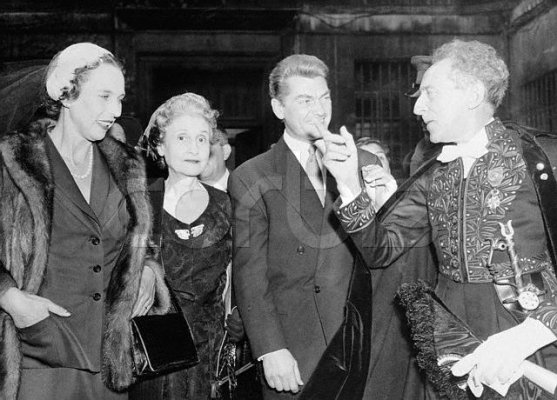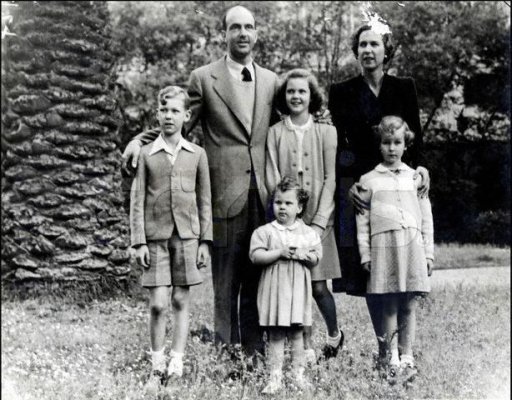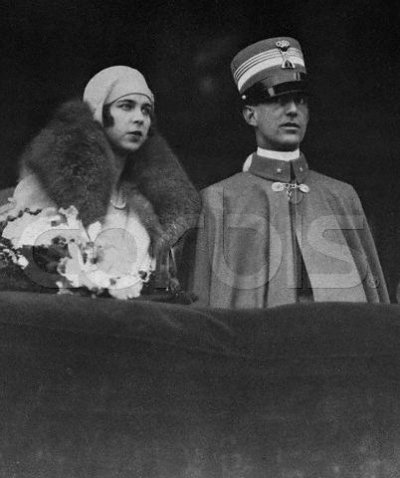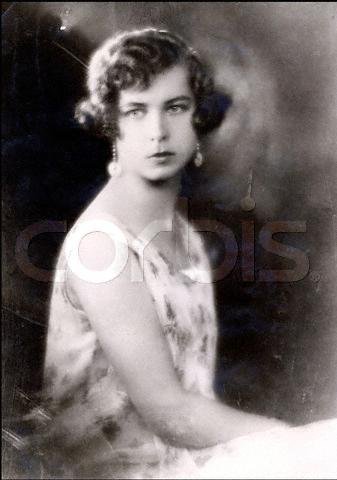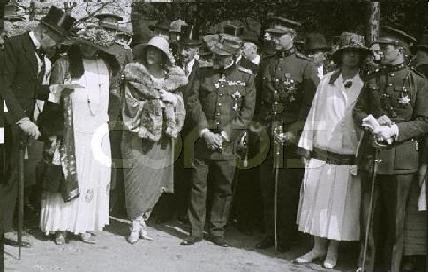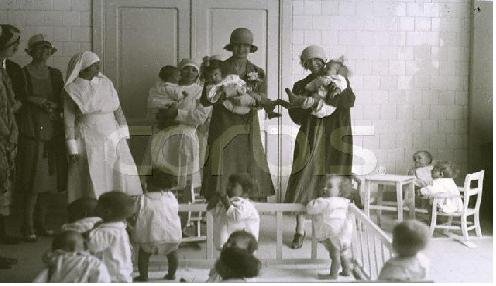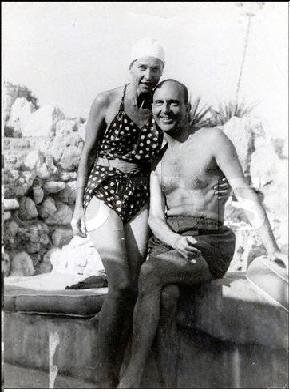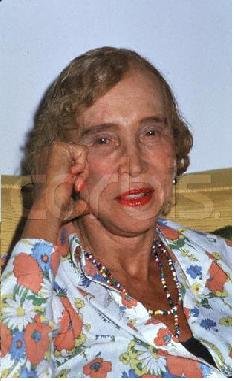The May Queen
Queen Marie-José of Italy (1907-2001)
By Art Beéche
Surprising, non-conformist, original and above all royal. Her Majesty Queen Marie-José of Italy has not changed. Installed for some years now at her villa in Cuernavaca, Mexico, the former Italian sovereign demonstrates today the same curiosity that has characterized her throughout life. Her white villa and the surrounding garden, vibrant with bougainvilleas and exotic vegetation, are filled with charm.
Marie-José discovered Mexico in the company of Princess Marie-Beatrice of Italy, her youngest daughter. Together they have visited many of the country's archaeological sites, among them the ruins at Tajin, only recently opened to the public. The former Queen of Italy chose Mexico to be near her daughter and grandchildren. She acquired her villa, which is close to that of her family, because it has excellent acoustics which allow Marie-José to play piano concerts for her family and friends. The Queen has brought along her Bechstein piano, an excellent instrument presented to her by her music-loving parents, King Albert I and Queen Elisabeth of Belgium in 1930.
Music has always played an important role in the Queen's life. "I'm a musician, my parents were musicians, I have been able to meet the greatest virtuosos and composers. To encourage creativity I created the International Prize Queen Marie-José for musical composition in 1960. I'm currently helping a young Mexican who is studying music in Germany." The Queen assiduously attends musical performances at the Palace of Beaux Arts in Mexico City, and is constantly visited by young Mexican musicians.
Yet the Queen's days are not just dedicated to music. History, her other passion, has always played an important role in the life of Marie-José. She recently read a biography of her great-aunt, Queen Marie of Naples, wife of King Francis II of the Two-Sicilies. "As a child I remember visiting my old aunt, whose husband was dethroned by the Savoys in 1860 during Italian unification. After greeting her...she pointed her finger at me and said...And you, I do hope you will never marry that little Umberto of Savoy!" Curiously enough, Princess Marie-José of Belgium married prince Umberto of Savoy in 1930. Her Aunt Marie was the last Queen of the Two-Sicilies, Marie-José was the last Queen of Italy.
Queen Marie-José is also recognized as one of the world's leading specialists in the history of the House of Savoy. She has published several works on her husband's family and is currently writing a biography of Prince Emmanuel-Philibert, ancestor of her children.
Marie-José celebrated her ninety-first birthday this year. Her life, after a happy childhood and youth in Belgium, has been filled with challenges, suffering and tragedy. Her marriage to Prince Umberto was not a happy one, for neither royal spouse was much interested in the other. The first four years of marriage were filled with constant bickering and a growing separation between Umberto and Marie-José. Their children caused the royal couple several headaches during much of the 1960's. One of her grandsons died in mysterious circumstances by falling off a window just a few years ago. Marie-José's father died tragically as a result of a climbing accident. One of her sisters-in-law, Princess Mafalda of Hesse, died while in a concentration camp. Another sister-in-law, Queen Astrid of Belgium, died in a car accident. In the midst of all these family tragedies, Marie-José has retained hope for her last years and the eventual closing of the many rifts which have divided the Savoy family.
Throughout all these years, Marie-José has remained close to her royal nephews in Belgium. She never abandoned her Belgian roots. In 1993 she attended the funeral of King Baudouin I in Brussels. She has been visited by her other nephew, King Albert II, while in Cuernavaca.
Marie-José is no longer barred from entering Italy. She and her husband, King Umberto II were ousted by popular plebiscite in May, 1946. For decades, the Italian Republic banned the return of the Savoys. In exile, Umberto II and Marie-José separated. He settled in Cascais, Portugal; she in Switzerland. Umberto never again set foot in Italy.
In 1929 the Royal Court of Belgium solemnly announced the engagement of Princess Marie-José to Crown Prince Umberto of Italy. Inside the palace walls, Marie-José did not share the enthusiasm of both families and the populace in general. Still, as a daughter of kings and a royal princess, she felt obligated to fulfill her public duties. In 1930 she married the Italian royal heir and became the Princess of Piedmont. The first years of marriage were a challenge to the vastly divergent couple. At times it seemed that their union was close to reaching a complete collapse. Umberto was a playboy with particular sexual tastes which did not discriminate between the sexes. Marie-José was a tremendously talented young woman with deep artistic and intellectual inclinations. Their first child, Princess Maria-Pia was born in 1934. In 1937 an heir was born when Marie-José gave birth to Prince Victor-Emmanuel, who was followed by Marie-Gabrielle in 1940 and finally Marie-Beatrice in 1943.
At the time of Marie-José's marriage to Umberto, Italy was under the political dictatorship of Benito Mussolini. Marie-José, raised in the very democratic atmosphere of Brussels, felt a deep aversion to the fascist undercurrent expanding throughout Europe. She clashed constantly with Italy's government, and even confronted Adolf Hitler during the Second World War. She vainly tried to obtain the freedom of Belgian prisoners of war.
The long Mussolini dictatorship, as well as the German alliance during the Second World War, doomed the future of the Savoy monarchy. After the Allied invasion of Italy, old King Victor-Emmanuel III abdicated in his son's favor in a last effort to safe the Italian monarchy. On 9 May 1946, Umberto II and Marie-José became the new Italian monarchs. Their opposition to Mussolini had gained them vast popularity, yet the crown's cooperation with the fascist dictator had raised widespread opposition among many Italians. The house of Savoy had tainted itself by allowing, and contributing, to Mussolini's ascendancy to absolute power in Italy. Even though Umberto and Marie-José tried to restore the tarnished image of the Savoys, there efforts were too late. Barely one month after ascending the throne, Umberto II called for a referendum to decide the future of the Italian monarchy. The Savoys lost by a small margin.
The referendum of 1946 gave the republican sectors a marginal majority. Many politicians close to the Savoys tried to convince Umberto II to fight the results. Fraud seemed to have been widespread. The monarchy could have had a chance, yet taking this action would have plunged the country into civil war. Italy, already devastated by the Second World War, could hardly afford any more civil and political strife. Faced with these choices, Umberto II refused to plunge the country into any more political violence. He and Marie-José, accompanied by their family, left Italy without abdicating the crown. The exiled monarchs joined Umberto's parents in Egypt. Some time later, Umberto settled in Cascais, Portugal. Marie-José found it impossible to live with her husband any longer, eventually settling in Switzerland.
From exile in Portugal, Umberto II unsuccessfully tried to convince the Italian government to abrogate the law of exile imposed in 1947. This law singled out male members of the House of Savoy from ever entering Italian territory. As their life in exile continued without the hope of a royal restoration, Umberto II and Marie-José separated. The children were deeply affected by the collapse of family life and began to provide their parents with much grief and embarrassment. Divorces, drug-addiction, love scandals and court proceedings became commonplace among the younger generation of Savoys.
Umberto II died in 1983. He was never able to return to his beloved Italy. His body was interred in Portugal, where it remains to this day. Marie-José has remained a constant presence in the life of her children, most of which seem to have encountered some degree of inner peace. The Italian law of exile remains in place, Victor-Emmanuel and his son, Emmanuel-Philibert continue to live in exile. Italy is no longer barred from old Queen Marie-José. She has visited the country several times, usually in the company of her daughter Marie-Gabrielle, another accomplished historian and Savoy expert. Yet, Marie-José refused to settle in Italy because the Law of Exile still applies to her son and grandson. The last Queen of Italy prefers to ignore the past and avoid nostalgic reminiscences, instead she much prefers to look at the future and the possibilities life may provide.
From:European Royal History
Queen Marie-José of Italy (1907-2001)
By Art Beéche
Surprising, non-conformist, original and above all royal. Her Majesty Queen Marie-José of Italy has not changed. Installed for some years now at her villa in Cuernavaca, Mexico, the former Italian sovereign demonstrates today the same curiosity that has characterized her throughout life. Her white villa and the surrounding garden, vibrant with bougainvilleas and exotic vegetation, are filled with charm.
Marie-José discovered Mexico in the company of Princess Marie-Beatrice of Italy, her youngest daughter. Together they have visited many of the country's archaeological sites, among them the ruins at Tajin, only recently opened to the public. The former Queen of Italy chose Mexico to be near her daughter and grandchildren. She acquired her villa, which is close to that of her family, because it has excellent acoustics which allow Marie-José to play piano concerts for her family and friends. The Queen has brought along her Bechstein piano, an excellent instrument presented to her by her music-loving parents, King Albert I and Queen Elisabeth of Belgium in 1930.
Music has always played an important role in the Queen's life. "I'm a musician, my parents were musicians, I have been able to meet the greatest virtuosos and composers. To encourage creativity I created the International Prize Queen Marie-José for musical composition in 1960. I'm currently helping a young Mexican who is studying music in Germany." The Queen assiduously attends musical performances at the Palace of Beaux Arts in Mexico City, and is constantly visited by young Mexican musicians.
Yet the Queen's days are not just dedicated to music. History, her other passion, has always played an important role in the life of Marie-José. She recently read a biography of her great-aunt, Queen Marie of Naples, wife of King Francis II of the Two-Sicilies. "As a child I remember visiting my old aunt, whose husband was dethroned by the Savoys in 1860 during Italian unification. After greeting her...she pointed her finger at me and said...And you, I do hope you will never marry that little Umberto of Savoy!" Curiously enough, Princess Marie-José of Belgium married prince Umberto of Savoy in 1930. Her Aunt Marie was the last Queen of the Two-Sicilies, Marie-José was the last Queen of Italy.
Queen Marie-José is also recognized as one of the world's leading specialists in the history of the House of Savoy. She has published several works on her husband's family and is currently writing a biography of Prince Emmanuel-Philibert, ancestor of her children.
Marie-José celebrated her ninety-first birthday this year. Her life, after a happy childhood and youth in Belgium, has been filled with challenges, suffering and tragedy. Her marriage to Prince Umberto was not a happy one, for neither royal spouse was much interested in the other. The first four years of marriage were filled with constant bickering and a growing separation between Umberto and Marie-José. Their children caused the royal couple several headaches during much of the 1960's. One of her grandsons died in mysterious circumstances by falling off a window just a few years ago. Marie-José's father died tragically as a result of a climbing accident. One of her sisters-in-law, Princess Mafalda of Hesse, died while in a concentration camp. Another sister-in-law, Queen Astrid of Belgium, died in a car accident. In the midst of all these family tragedies, Marie-José has retained hope for her last years and the eventual closing of the many rifts which have divided the Savoy family.
Throughout all these years, Marie-José has remained close to her royal nephews in Belgium. She never abandoned her Belgian roots. In 1993 she attended the funeral of King Baudouin I in Brussels. She has been visited by her other nephew, King Albert II, while in Cuernavaca.
Marie-José is no longer barred from entering Italy. She and her husband, King Umberto II were ousted by popular plebiscite in May, 1946. For decades, the Italian Republic banned the return of the Savoys. In exile, Umberto II and Marie-José separated. He settled in Cascais, Portugal; she in Switzerland. Umberto never again set foot in Italy.
In 1929 the Royal Court of Belgium solemnly announced the engagement of Princess Marie-José to Crown Prince Umberto of Italy. Inside the palace walls, Marie-José did not share the enthusiasm of both families and the populace in general. Still, as a daughter of kings and a royal princess, she felt obligated to fulfill her public duties. In 1930 she married the Italian royal heir and became the Princess of Piedmont. The first years of marriage were a challenge to the vastly divergent couple. At times it seemed that their union was close to reaching a complete collapse. Umberto was a playboy with particular sexual tastes which did not discriminate between the sexes. Marie-José was a tremendously talented young woman with deep artistic and intellectual inclinations. Their first child, Princess Maria-Pia was born in 1934. In 1937 an heir was born when Marie-José gave birth to Prince Victor-Emmanuel, who was followed by Marie-Gabrielle in 1940 and finally Marie-Beatrice in 1943.
At the time of Marie-José's marriage to Umberto, Italy was under the political dictatorship of Benito Mussolini. Marie-José, raised in the very democratic atmosphere of Brussels, felt a deep aversion to the fascist undercurrent expanding throughout Europe. She clashed constantly with Italy's government, and even confronted Adolf Hitler during the Second World War. She vainly tried to obtain the freedom of Belgian prisoners of war.
The long Mussolini dictatorship, as well as the German alliance during the Second World War, doomed the future of the Savoy monarchy. After the Allied invasion of Italy, old King Victor-Emmanuel III abdicated in his son's favor in a last effort to safe the Italian monarchy. On 9 May 1946, Umberto II and Marie-José became the new Italian monarchs. Their opposition to Mussolini had gained them vast popularity, yet the crown's cooperation with the fascist dictator had raised widespread opposition among many Italians. The house of Savoy had tainted itself by allowing, and contributing, to Mussolini's ascendancy to absolute power in Italy. Even though Umberto and Marie-José tried to restore the tarnished image of the Savoys, there efforts were too late. Barely one month after ascending the throne, Umberto II called for a referendum to decide the future of the Italian monarchy. The Savoys lost by a small margin.
The referendum of 1946 gave the republican sectors a marginal majority. Many politicians close to the Savoys tried to convince Umberto II to fight the results. Fraud seemed to have been widespread. The monarchy could have had a chance, yet taking this action would have plunged the country into civil war. Italy, already devastated by the Second World War, could hardly afford any more civil and political strife. Faced with these choices, Umberto II refused to plunge the country into any more political violence. He and Marie-José, accompanied by their family, left Italy without abdicating the crown. The exiled monarchs joined Umberto's parents in Egypt. Some time later, Umberto settled in Cascais, Portugal. Marie-José found it impossible to live with her husband any longer, eventually settling in Switzerland.
From exile in Portugal, Umberto II unsuccessfully tried to convince the Italian government to abrogate the law of exile imposed in 1947. This law singled out male members of the House of Savoy from ever entering Italian territory. As their life in exile continued without the hope of a royal restoration, Umberto II and Marie-José separated. The children were deeply affected by the collapse of family life and began to provide their parents with much grief and embarrassment. Divorces, drug-addiction, love scandals and court proceedings became commonplace among the younger generation of Savoys.
Umberto II died in 1983. He was never able to return to his beloved Italy. His body was interred in Portugal, where it remains to this day. Marie-José has remained a constant presence in the life of her children, most of which seem to have encountered some degree of inner peace. The Italian law of exile remains in place, Victor-Emmanuel and his son, Emmanuel-Philibert continue to live in exile. Italy is no longer barred from old Queen Marie-José. She has visited the country several times, usually in the company of her daughter Marie-Gabrielle, another accomplished historian and Savoy expert. Yet, Marie-José refused to settle in Italy because the Law of Exile still applies to her son and grandson. The last Queen of Italy prefers to ignore the past and avoid nostalgic reminiscences, instead she much prefers to look at the future and the possibilities life may provide.
From:European Royal History


